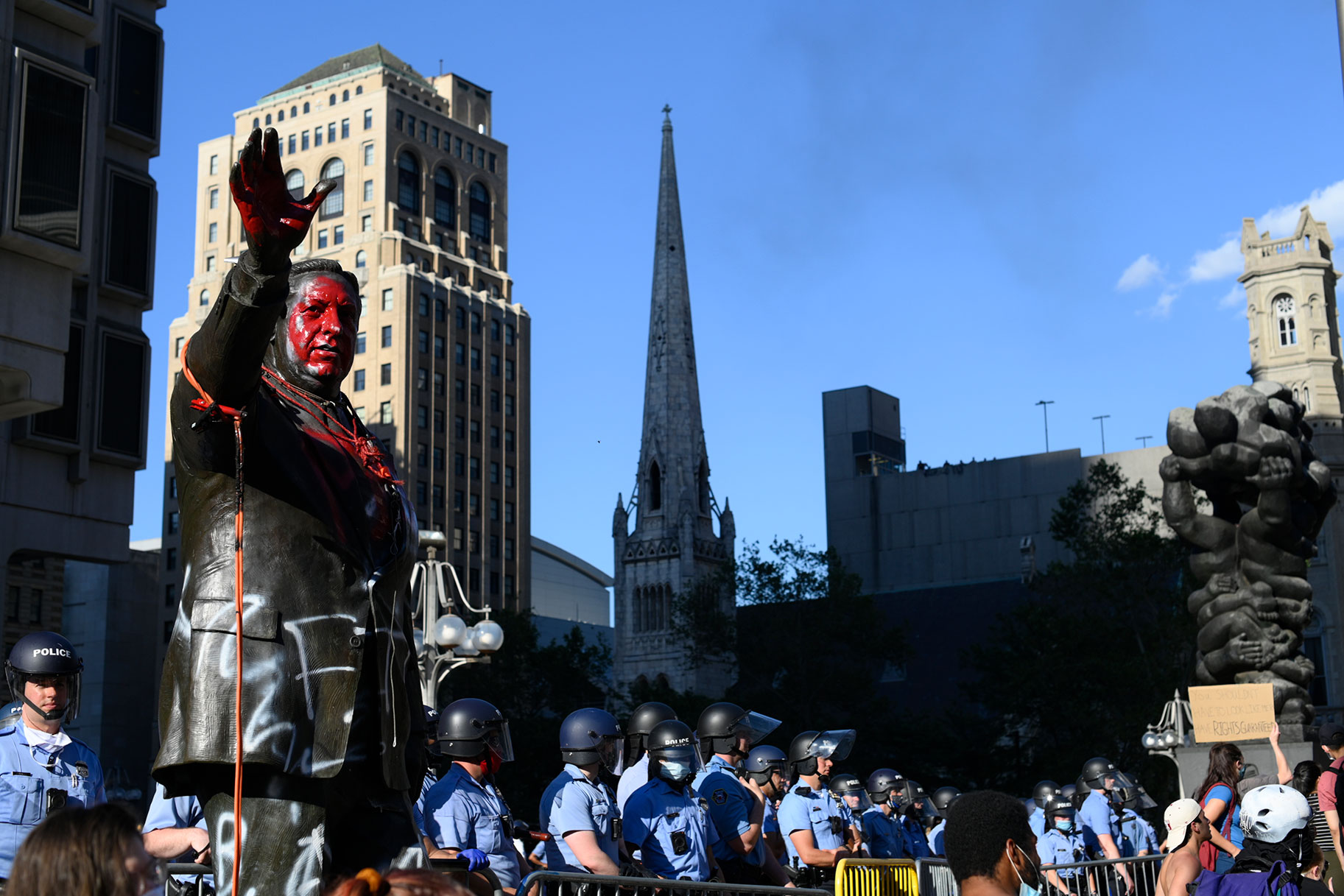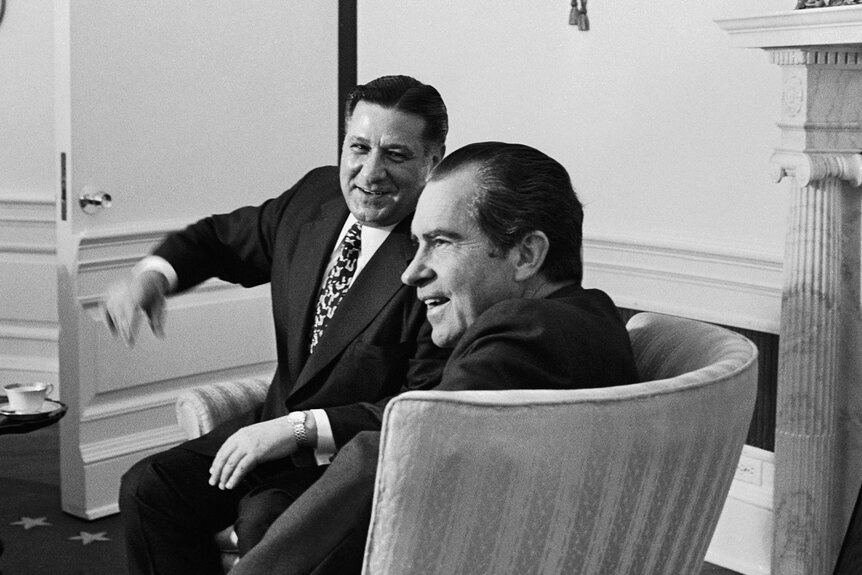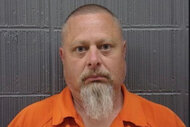Create a free profile to get unlimited access to exclusive videos, breaking news, sweepstakes, and more!
Philadelphia Removes Statue Of Former Mayor Frank Rizzo, Who Implored Residents To 'Vote White'
Frank Rizzo, a former Philadelphia police commissioner who went on to serve two terms as mayor from 1972 to 1980, had a history of antagonizing the city's black and LGBTQ communities.

This week saw the removal of Philadelphia's imposing statue of former Mayor Frank Rizzo, a controversial figure in the city's history whose statue had become the focal point of dozens of protests throughout the years.
Rizzo, who died in 1991, was a two-term Democratic mayor from 1972 to 1980, winning his first term after serving four years as the city's police commissioner from 1968 to 1971. His 2,000-pound, 10-foot-tall bronze statue has sat in front of Philadelphia's Municipal Services Building since 1999, according to CBS News.
Rizzo's legacy in the city is considered divisive as best, having served as Philadelphia's first Italian-American police commissioner and a point of pride for his childhood neighborhood of South Philadelphia — though he is better known for his frequent antagonization of the city's black and LGBTQ residents.
“This is the beginning of the healing process in our city,” Mayor Jim Kenney said Wednesday morning as he stood near the empty area where the statue had been before its removal overnight, according to The New York Times. “This is not the end of the process. Taking the statue down is not the be all and end all of where we need to go."
Rizzo's son and former Philadelphia city councilor Frank Rizzo Jr. said he did not learn about the statue's removal until city police texted him early Wednesday about it.
“There are people who love him. There are people who dislike him,” Rizzo Jr. said to The New York Times. “He loved Philadelphia as much as he loved his family.”
“I’m very disappointed about how it was handled," he said.
The removal comes shortly after it was again vandalized during Philadelphia's protest against police brutality following the death of George Floyd, according to NPR.
"The statue represented bigotry, hatred, and oppression for too many people, for too long. It is finally gone," Kenney tweeted Wednesday.
Timothy J. Lombardo, an assistant professor of history at the University of Southern Alabama and author of "Blue-Collar Conservatism: Frank Rizzo's Philadelphia and Populist Politics," spoke with Oxygen.com about what the statue's removal means and Rizzo's legacy.
"It's definitely been a long time coming and it's been something that Mayor Kenney has said he was going to do," Lombardo said. "In my opinion I think it was an acceleration of an inevitability."
"It's definitely been something people have clamored for since it went up. ... There hasn't been a time where it wasn't regularly vandalized," he continued, adding that the statue often naturally became a center point of protest due to the Rizzo administration's bigoted attitudes toward certain communities within the city.
"[It's] a remnant and symbol of an era that no longer exists," Lombardo said. "These symbols all sort of instigate these protests in the first place."
Rizzo first rose to major prominence following his appointment as commissioner in 1968.
"He was a divisive figure who very harshly tried to enforce 'law and order' at the expense of people of color, at the expense of gay men and women, at the expense of any sort of dissenters," Lombardo said.
Infamously, the police department under Rizzo saw a massive raid on Philadelphia's chapter of the Black Panther Party in 1970 where members of the group were strip-searched in front of cameras. Photos of the strip search ran on the front page of the Philadelphia Daily News, according to Philadelphia Magazine.
The strip search was later ruled illegal and the charges filed against the Black Panther Party members were dropped.
"They should be strung up. I mean within the law. This is actual warfare," Rizzo said of the Black Panthers, according to the Washington Post in 1977.
He was elected in 1972, claiming he ran "to prevent the do-gooders and ultra-liberals from taking over," the Washington Post reported in 1977. Rizzo was not an orthodox Democratic politician — he endorsed Richard Nixon's re-election for president in 1972.
Lombardo explained that Rizzo was a key figure in Nixon's strategy to win over voters in traditional Democratic strongholds.
During his mayoralty, Rizzo opposed desegregating the public school system and prevented the construction of public housing in majority-white neighborhoods. He is also often accused of inflaming tensions with Philadelphia-based black liberation group MOVE — culminating in a 1978 shootout that resulted in the death of a Philadelphia police officer and life sentences for nine members of MOVE, according to Philadelphia's 6ABC.
The city's adversarial stance toward the group would continue past Rizzo's tenure — culminating the police bombing a MOVE home in 1985. The bombing burnt the residence down, starting a fire that engulfed essentially a full city block of homes and killed 11 members of MOVE, including five children, according to Vox.
Approaching the end of his second term in the 1970s, Rizzo moved to amend the city charter to allow him to run for a third consecutive term. He urged voters to "vote white" during the campaign for a change to the charter, the New York Times reported in 1978. The amendment was rejected by residents in a near two-to-one vote, roughly 458,000 to 238,000.
In 1979, the Department of Justice under then-President Jimmy Carter accused the city of Philadelphia, Mayor Frank Rizzo and 18 top city and police officials of condoning systematic police brutality that "shocks the conscience," The Washington Post reported at the time.
"I hope we're not going the way of Iran — that policemen, just because they wear a blue uniform, are summarily rounded up and executed," Rizzo told the Post in response. "I'm ready to tell them they can stick it."
Rizzo did not hide his dislike for groups that opposed him, frequently attacking reporters who wrote critical stories or demeaning political opponents and protestors alike. NBC News' chief foreign affairs correspondent and anchor Andrea Mitchell, who reported for local Philadelphia media during Rizzo's tenure, said that Rizzo often tried to get her fired for her reporting.
"When I'm finished with them, I'll make Attila the Hun look like a f----t," Rizzo reportedly said of his enemies, according to his obituary in The New York Times.
Rizzo attempted to run for office again in 1983, but would lose the Democratic primary to W. Wilson Goode — who went on to serve as the city's first black mayor from 1984 to 1992. Rizzo proceeded to switch parties and challenged Goode in the 1987 election as a Republican. Goode won the election with 333,254 votes to Rizzo's 319,053, according to data provided by the city of Philadelphia.
Following the end of Goode's two terms, Rizzo again won Republican primary for Philadelphia's 1991 mayoral election — seeking a third term in office. However, he died of a heart attack at age 70 during the campaign and his replacement lost the election to former Philadelphia District Attorney Ed Rendell.
The statue was donated to the city in 1999 by friends and family of Rizzo, according to CBS News.
"Now in the present, you have this monument to him — this monument that stands as a symbol to that person. As a historian I always tell people you don't learn from statues, the only thing you learn from statues is reverence. And you have this towering statue in the middle of Center City asking you to revere this person who very clearly didn't revere all of Philadelphia," Lombardo told Oxygen.com.
"The statue, installed in 1999, will be placed in secure storage by the Department of Public Property until a plan is developed to donate, relocate, or otherwise dispose of it," the mayor's office said in a statement.
Lombardo doubts the statue will go up for public view again.
"Let's be frank, Philadelphia's not going to elect the type of politician who runs on 'Let's put the Rizzo statue back up,'" Lombardo said.
Lombardo also stressed that the conversation about Rizzo's legacy should inform decision makers in urban centers across the country.
"As cities continue to struggle, as we continue to see these very, very similar confrontations ... I think it's important to look to the past," he said. "We should use the past and learn from it, rather than project it as exemplary."
Speaking more on the ongoing protests roiling America, Lombardo pointed that it is important to ask why these protests have become so widespread in the first place, and how the history and development of America's cities resulted in rampant inequality.
"The broader question that should be on more people's minds ... is how did it come to this? We've had one of the single largest periods of civil unrest this nation has seen at least since 1992: how did that happen?" Lombardo said. "That should be the question we're all asking."
For the latest reporting on the George Floyd protests from NBC News and MSNBC’s worldwide team of correspondents, including a live blog with minute-to-minute updates, visit NBCNews.com and NBCBLK.























